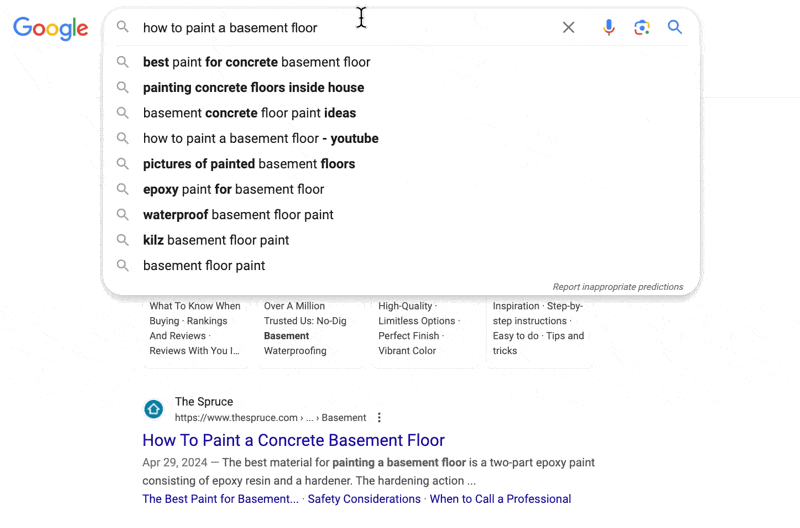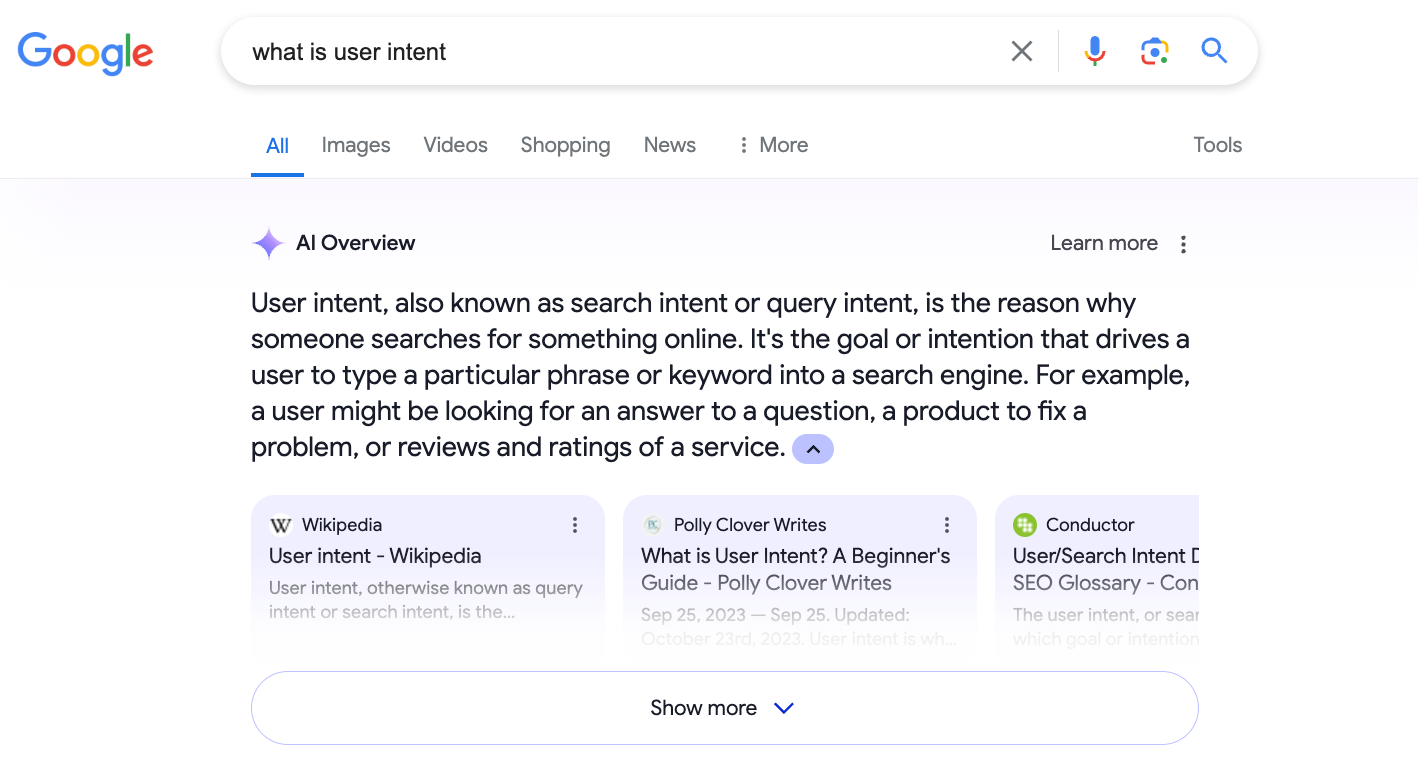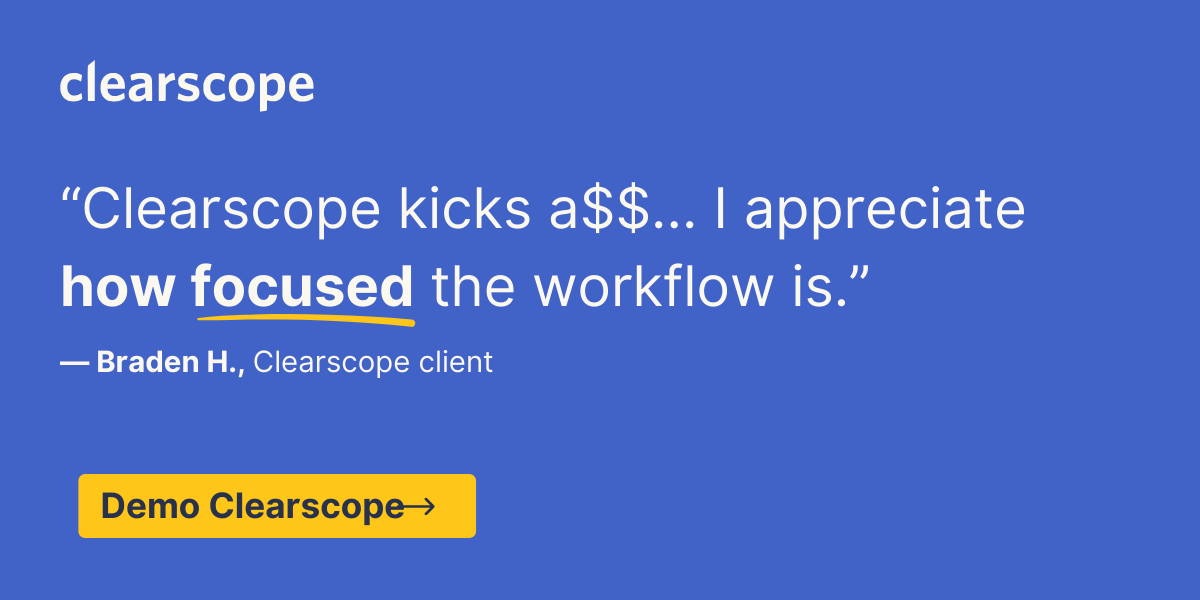How to Optimize for Search Intent to Earn Better Rankings and More Conversions
Topic: Strategy
Published:
Written by: Bernard Huang
Stop optimizing for SEO keywords. Start optimizing for user search intent.
This might sound counterintuitive to everything you’ve been taught about search engine optimization in the past, but I’m going to show you how to do it in this article.
And no, you don’t have to throw away all those hard-earned, well-organized keyword lists. However, you might be relieved to (finally) rely on them significantly less.
Curious about what is search intent exactly?
I won’t be going in-depth here on what it is or how to analyze for user intent.
Instead, check out What is search intent, The different types of search intent, or How to analyze for search intent, depending on what you need today.
How to optimize content based on search intent
Once you’ve identified the search intent for your keyword and analyzed the Search Engine Results Page (SERP), you have a wealth of information to use to create high-quality, relevant content.
Here’s how to use intent to inform your on-page SEO strategy.
These are the things you’ll want to consider to optimize for search intent correctly:
Content format
Article or page format
Query Deserves Freshness
Visuals included
SERP features
Meta title and description
Backlinks
Call to action
READ MORE: Why is keyword research important?
Content format
Pay attention to the content format that best honors or resolves the search intent.
If Google serving your target users:
Step-by-step long form articles > Then create a better more perspective-driven step by step content will fulfill search intent
Breaking news articles from experts about a hot topic > Then offer an in-depth expert interview about the topic from a new perspective is likely to serve your users best
Videos from YouTube > Then develop a video that showcase your product, service, or answer questions about the topic at hand
Case studies demonstrating success metrics > Then show the success stories of clients who have used your specific product with data to back it up
Ecommerce product pages from a variety of stores > Then users are looking for optimized product listings that resolve the need demonstrated by the search query
AI Overview content > Then strategize SEO optimized content in the topic that offers information gain, originality, and new perspectives your target user can discover—and that AI cannot generate
Article or page format
Another element you’ll want to consider for search intent optimization is the structure or format of your content.
For instance, if there is a commercial or transactional search intent behind the need, you’ll want a sweet product or landing page that’s optimized both for SEO and conversion, because these are high-intent queries.
For instance, product comparison pages between you and your top competitors with a call to action (CTA) to demo your product are ideal for capturing queries with commercial intent.
In contrast, you can create a guide that uses subheaders to break down each process step to optimize for an informational search intent like [how to paint a basement floor].

Google SERP results for [how to paint a basement floor] reveal the type of content that best meets user intent, as understood by the search engine.
As you outline each piece of content and think about the structure, it can be useful to look at what the competition is doing. Then, see if there are ways you can improve upon it.
Query Deserves Freshness
Way back in 2017, Google rolled out an algorithm update called Query Deserves Freshness (QDF) and it has become a significant ranking factor today.
QDF makes sure search results deliver up-to-date information, and especially so for specific types of search queries, like [mortgage rates June current year].

Google SERP results for [mortgage rates June current year] reveal the type of recent content that best meets user intent.
And if you’re targeting a search query that produces these kinds of results, you know you need to provide timely, regularly updated information to best serve your target audience.
Keep in mind, when recent information is needed to satisfy user intent, older, outdated pages drop lower in the rankings (or disappear entirely) to make way for pages with fresher content.
To do so, Google monitors if three things are increasing:
Search query interest
Citations and mentions across the web
Topic interest via news portals
If search requests are higher than average for a specific topic, the algorithm may consider a freshness. The algorithm tests for relevancy and ranks new content for this topic higher on the search results.
This means if you have a page that ranked well for a particular keyword but its rankings start to decline, you may have a search intent problem—something in the user’s needs for that query likely has changed. Go back and improve on existing content.
Visuals
User intent also helps you determine which types of images, infographics, and media elements are most helpful to your target audience.
Ask yourself, What type of visuals will help the reader reach their goal faster?
You can create a step-by-step tutorial infographic if the goal is understanding a process. However, if your reader wants to research a product before buying it, you can show images of the product (or screenshots if it’s software).
The same concept applies to video content. You want to highlight the information that’s most relevant based on intent.
In my experience, I’ve found embedding related YouTube content if it supports fulfilling search intent alongside an educational article can be beneficial in ranking your long-form piece, whether the YouTube content is yours or belongs to another creator.
The key to remember here is offering the best experience to the human behind the search, including linking to outside resources that help do so.
SERP features
Analyzing the SERP for audience intent lets you identify opportunities to rank for different types of results, such as featured snippets, People Also Ask questions, AI Overviews, and rich snippets.
Let’s say the search results for your targeted keyword has an AI Overview result for that query.
These are the questions you should be asking yourself before deciding on what type of content to develop to meet the intent of this query:
What kind of perspective-driven content can you create that would best support this automatic AI Overview?
How can you add first-person, human originality to the short answer Google is providing?
What sort of information gain can you add to the topic at hand?
What experiences have you had with this particular topic that you can warn, share, inform other users about?
For example, here’s an AI Overview related to the content that I’m writing about right now: [what is user intent].

Google AI Overview for [what is user intent].
What can I provide that expands on this AI Overview with originality? How can I provide new information, like expert interviews, survey data, and personal experience, to support this AI Overview?
As for the People also ask feature, look at the questions that pop up. Then, include an answer for each in your article, or if search intent warrants it, use Ranch-style SEO frameworks to create perspective-driven content for each unique question.
Finally, look at the rich snippets on the SERP and use structured data on your post or page that fits the result type.
For example, if you’re creating a recipe, you’ll want to follow Google’s recipe schema markup instructions. That way, the search engine can include your content in the enhanced result sections.
Google provides general structured data guidelines and specific instructions for each feature.
Meta title and description
Google often automatically chooses a page title and description to display in search results, but that doesn’t mean you should overlook this element.
Consider user intent when creating meta titles and descriptions.
Aligning your title and description with the appropriate search intent can signal to Google you’re optimizing for intent and increase your click-through rate to get more qualified leads to your specific website.
Here are some ways you can optimize your SERP result for each intent.Informational intent: Use the title to explain the post, including terms like “step-by-step guide” or “detailed comparison” that tell the reader how your page answers their question.
Navigational intent: Keep your title simple and to the point, and use the description to describe the action they can take if they click your link.
Transactional intent: Include brands, product names, and feature descriptions. Mention shopping-relevant features, such as free shipping or discounts. Use clear call-to-action language, such as “order now” or “try free for 7 days.”
Commercial intent: Use product and brand names in your title and write descriptions that include product specifications and pricing information. If you’re writing a product comparison article, summarize your findings in the meta description.
Local intent: Use clear signals in your copy that this specific webpage serves the community that you’re targeting.
READ MORE: Are there more than 4 or 5 search intents? We think so. Check out The different types of search intent for a deep dive.
Backlinks
If you’ve been in the digital marketing game for any length of time, you already know that earning the right backlinks is important.
While we would argue they’re just one small part of an overall robust SEO strategy, they are still an piece of the puzzle to get your high-quality content to show up on the first page of Google.
In fact, May 2024 Google data leaks confirmed that backlinks are an important consideration in ranking—but low-quality backlinks aren’t ideal.
So not just any backlink will do.
Optimizing for search intent also can include optimizing your content by seeking out the right kind of backlinks on quality, trustworthy sites that have similar areas of topical authority or target audiences to yours.
Call to action (CTA)
Finally, your call to action (CTA) on any page should be relevant to user intent and where your reader falls along the customer journey.
You don’t want your target users to come all that way after popping their user queries into a search bar, reading through your killer content, and then heading right back out the door because your CTAs weren’t doing it.
After all, we SEOs don’t just deeply know our searchers, Google’s algorithms, and keyword intents only to lower bounce rates and target top search volumes.
We’re in it for those sweet organic traffic conversions.
Lower-stakes CTAs that offer users to learn more, secure a freebie, or subscribe to a newsletter work better for informational search queries and navigational intent keywords where the user isn’t thinking about making a purchase just yet.
However, don’t be afraid to use your CTA to ask for the conversion when you optimize for high-intent keywords, like commercial, transactional, and even local.
At this point in the user journey, the reader is further along the customer journey and already considering a purchase or possibly an immediate local solution.
Matching your CTA to the right search intent can help increase your conversion rates at each step of your content marketing strategy.
Final thoughts: Understanding user intent is essential for better SEO results
Mastering search intent is crucial for modern SEO success, and traditional tools like Ahrefs and SEMrush can provide some insight into search intent categories.
But by analyzing search intent more deeply—by examining headings and the content structure of top-ranking pages—you can gain sharper insights into what works best for specific keywords and their targeted intents.
Whether it's informational queries or transactional queries, understanding the intent behind each target keyword is vital.
Ensure that your homepage and other critical pages are optimized for navigational search intent, guiding users seamlessly to their desired information.
Internal linking strategies can enhance user experience and keep visitors engaged by connecting them to related content throughout your site.
You can also use Google Analytics and Google Search Console to monitor the performance of your content and adjust your strategy accordingly, but the user’s need or goal behind a search query can evolve over time.
Search engines continue to get smarter so they can provide the most relevant results for their users. As marketers and content creators, we should follow their lead.
You can sharply stay on top of search intent changes by using content monitoring tools like Clearscope.
Clearscope is the #1 content-first SEO platform that helps you grow and protect your organic traffic. With Content Decay insights, Content Inventory Monitoring, and new Page Analytics features, you can make sure your existing and new content is always optimized for the correct search intent.
Request a personalized demo.

Why Is Keyword Research Important?
Keyword research means finding out what your target audience is already looking for online.
Read moreHow Chima Mmeje Uses Keyword Clustering To Generate Growth
Learn how content marketing manager Chima Mmeje uses keyword clustering to better organize and prioritize content efforts and generate explosive growth.
Read moreTopical Authority: The What and Why
Discover how topical authority improves your SEO results and the best practices you can use to improve your website’s credibility.
Read more